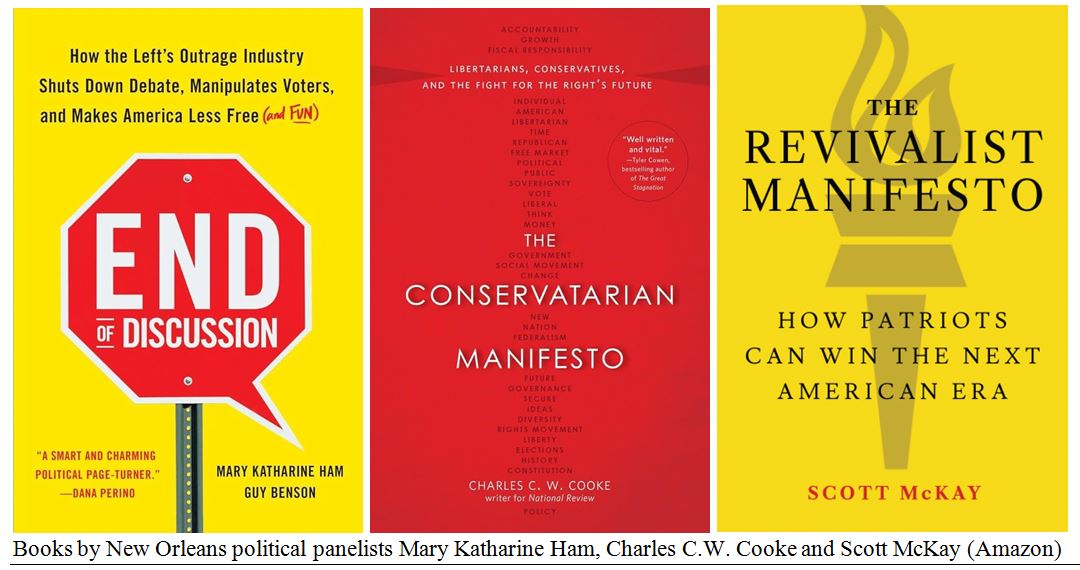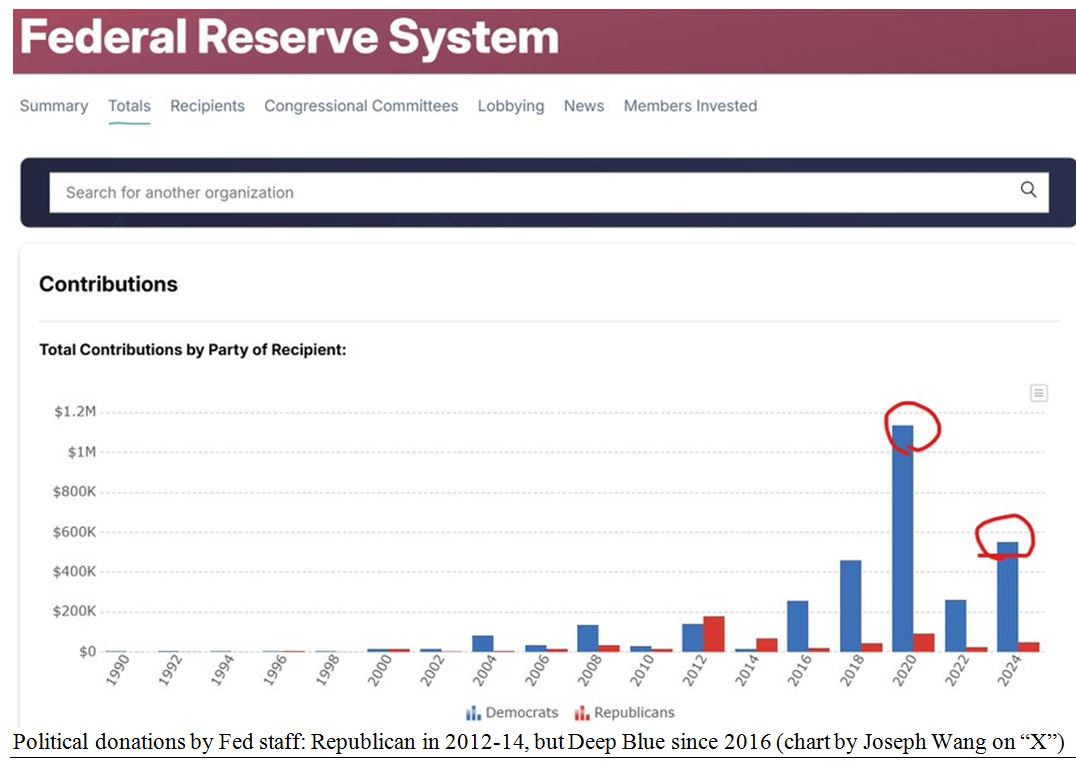by Gary Alexander
November 19, 2024
As you read this, I’m off to New Orleans for their 50th annual Investment Conference (my own 41st in a row as MC, panel moderator or speaker there). As usual (for the past 15 years), I’ll be chairing a closing geo-political panel, which in past years has included some fiery debates between James Carville and the late Charles Krauthammer, or Karl Rove vs. Howard Dean, or Newt Gingrich vs. the late libertarian comic P.J. O’Rourke, or a memorable cat-fight between Ann Coulter and Susan Estrich. The fur did fly.
For this event, the conference planners have avoided the high-paid and somewhat predictable political speakers in favor of well-spoken and far-seeing pundits who happened to call election results clearly, far in advance of the event. Their books, which anticipated the Trump first and second victories, respectively, are: (1) Mary Katherine Ham, co-author (with Guy Benson) of a truly fun and incisive 2015 book, “End of Discussion: How the Left’s Outrage industry Shuts Down Debate, Manipulates Votes, and Makes America Less Free (and Fun),” then, a pair of manifestos: (2) Charles C.W. Cooke’s “Conservatarian Manifesto: Conservatives, and the Fight for the Right’s Future” (2015) and then (3) Scott McKay’s 2022 “Revivalist Manifesto: How Patriots Can Win the Next American Era,” which clearly predicted Trump’s comeback in a year when Trump had to be the longest shot for a successful comeback in modern history.
These authors certainly offered more valuable insights than a barrel-full of Nobel-winning geniuses. Two weeks before the election, 23 Nobel Economic Prize laureates signed an open letter saying that Trump’s economics agenda would be disastrous for America, once again reflecting their myopia and group think:
“Simply put, Harris’ policies will result in a stronger economic performance, with economic growth that is more robust, more sustainable, and more equitable,” the Nobel laureates wrote in the letter. Donald Trump’s policies, they added, would “lead to higher prices, larger deficits, and greater inequality.” As for Harris, they wrote that she “has emphasized policies that strengthen the middle class, enhance competition, and promote entrepreneurship. On issue after issue, Harris’ economic agenda will do far more than Donald Trump’s to increase the economic strength and well-being of our nation and its people.” – summary from “Financial Review,” November 1, 2024
We can only hope that these “brightest minds in economics” (Bloomberg) didn’t hoover-up their stock profits and pay the penalties or taxes for cashing in their 401(k) withdrawals the next day, since they would have missed the 5% gains in the first week, and more to come, after last week’s “back and fill.”
The market’s manic reaction to the Trump win and Republican sweep is predictable, as I pointed out last week, since Republican sweeps are historically profitable, but last week I made the standard comparison of measuring full years without discounting for inflation. This time around, I’ll look at the last eight years from election day, since the day after the two Trump wins (and Biden’s 2020), markets soared right away, so we should account for the election honeymoon period in the winner’s favor and also discount for CPI erosion, while giving a nod to the composition of each Congress, which changed under both Presidents:
From this table, the net 4-year market gains under Trump and Biden favored Biden in nominal gains of 69.6% to 57.5%, but after-inflation gains favored Trump (+46%) over Biden (+40%). However, the split powers in Congress (2022-24) gave Biden all his gains, vs. his loss during his one-party sweep of 2020-22.
As I covered here last week, Republican electoral sweeps historically average about twice as many gains (+13.5% per year) as Democratic electoral sweeps (+6.7%) in historical market examples stretching back to 1950. (See Growth Mail, 11-12-24: The Market Implications of a Republican Sweep – Navellier)
DC is Moaning the “Blue Swamp Blues” About Now
As we can tell from President-elect Trump’s early appointments, he is serious about his two familiar slogans, both copied from Ronald Reagan: “Drain the Swamp” and “Make American Great Again.”
Critics can debate his choices, tactics and goals, but there is no doubt that the swamp is blue and will fight back, as alligators and other swamp creatures are well equipped to bite back. How blue is the DC swamp?
As we can tell from localized voting and political donations, the Swamp is Deep Blue. Denizens of the Beltway voted over 3-to-1 for Harris over Trump, and the closer you get to the Capitol, the bigger that number gets: 4-1 in nearby Virginia cities, 8-1 in Prince George’s county, and 14-1 in DC, even though the DC vote was less than it was for Biden in 2020 or Hillary in 2016. Just over 90% of DC voters opted for Harris (vs. 6.5% for Trump), down from 93% for Hillary and 92% for Biden. Nearby jurisdictions followed suit:
Graphs are for illustrative and discussion purposes only. Please read important disclosures at the end of this commentary.
I have first-hand experience with the Democrats’ power in Greater DC, as I ran for the Virginia State House of Delegates in 1997 against then 9-time incumbent Kenneth Plum. He is now a 21-time winner, in office 1982 to 2024. I like him, too. I sang two songs for him at his surprise 60th birthday party in 2001: “Young at Heart” and a reworking of Gilbert & Sullivan’s patter song from Pirates of Penzance, “He is the Very Model of a Democratic Delegate.” But Republicans and Independents (me) couldn’t beat him.
Political donations are harder to quantify, but a study just came out that our Federal Reserve governors and Fed staff contributed 11-to-1 to Democratic vs. Republican candidates in the three (Trump) cycles.
Graphs are for illustrative and discussion purposes only. Please read important disclosures at the end of this commentary.
Some of this Fed bias is evident from the fact that the previous (Obama era) Fed Chair (Janet Yellen) was appointed Secretary of the Treasury in the Biden White House, and former New York Fed president William Dudley said he was comfortable picking a fight against Trump and his policies. The Fed staff and some regional Governors (like Mary Daly at the San Francisco Fed) have also pushed for climate and DEI regulations as Fed mandates, beyond their financial mandates of limiting inflation and unemployment.
Trump’s cabinet is a work in progress – mostly youthful, loyalist and maybe inexperienced within the established power structure – but that is also their strength, as we need some radical change in how the system operates if we are to halt runaway budget deficits, global wars, behemoth government departments and their massive regulations. Not every nomination will pass, but most will, and the results may dazzle.
The post 11-19-24: What to Expect from Markets (and Swamp Creatures) in 2025 appeared first on Navellier.











